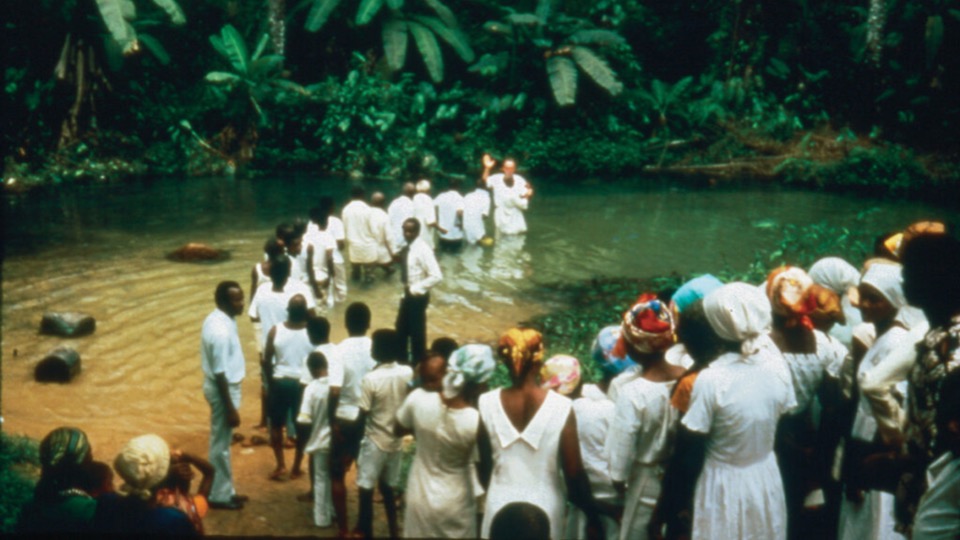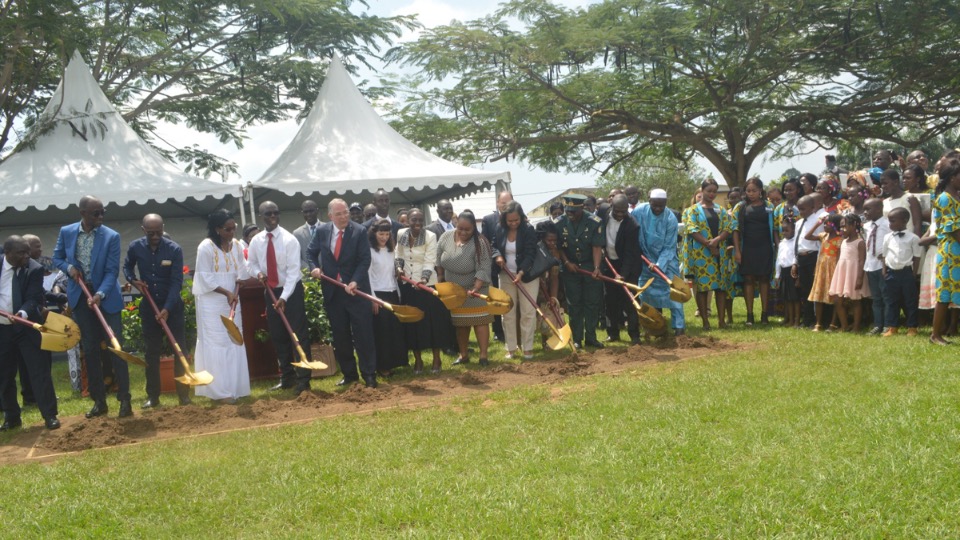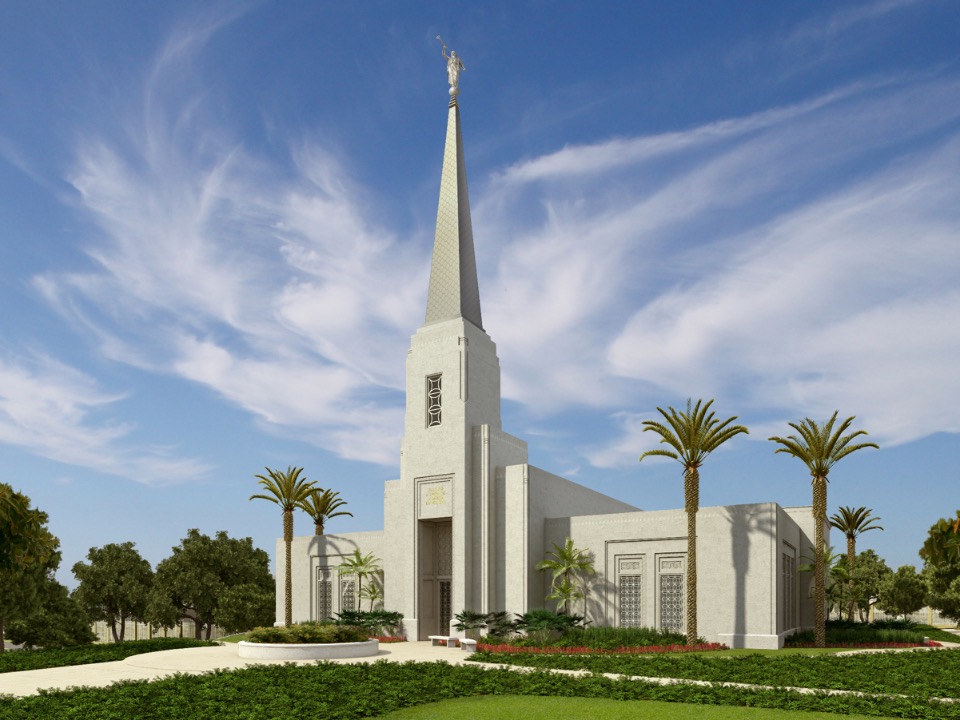
2e666b549925a965cf46f8dc328469cd70837a73Agoueto_Ward__Abobo_Stake_in_2000-e1657908105928.jpg
Members of the Agoueto Ward in the Abobo Ivory Coast Stake meet under a tree in the year 2000. Photo courtesy of Norbert K. Ounleu, courtesy of Church News. All rights reserved.This story appears here courtesy of TheChurchNews.com. It is not for use by other media.
By Mary Richards, Church News
Editor’s note: This month marks the 175th anniversary of the vanguard company of pioneers arriving in the Salt Lake Valley, in July 1847, after Latter-day Saints were driven by mobs out of the Nauvoo, Illinois, area the preceding year. The Church News this month honors achievements of pioneers crossing the Plains 175 years ago and also of Latter-day Saint pioneers of different times on every continent. Today: Norbert K. Ounleu of Africa’s Ivory Coast.
When a college friend gave a copy of the Book of Mormon to Norbert Kalogo Ounleu, he said he thought it was like any other book. But when he started reading it, he felt “a huge change happening.”
He was attending university in Abidjan, Ivory Coast, at the time. He knew his friend’s uncle did not allow her to meet the missionaries at his home, so Ounleu offered to have the missionary lessons at his home. He was baptized into The Church of Jesus Christ of Latter-day Saints on May 15, 1995, and his friend a month later.
Ounleu was impressed with the missionaries, and he wanted to be like them. He asked the branch president if he could serve a mission. There was one branch in the city, and only one district of the Church in the whole country at that time. The branch president told Ounleu he had to wait a year after being baptized, but by then he would be 26 and too old to go.
“But he advised me saying if you are married, you will serve a mission. But he didn’t tell me when. So I went to my friend and said, ‘Let’s get married so I can serve a mission!’” Ounleu said with a laugh.
He didn’t realize married couples usually serve when they are older and retired. “I was very new, but I was only excited to be like the missionaries.”
He and his friend got married anyway, while they were still in school. Two years later, in 1997, the first stake was created in the Ivory Coast, and Ounleu became the bishop of his ward.

lds-cn-13188.jpeg
Norbert and Valerie Ounleu when they were called as mission leaders in 2005. Photo courtesy of Norbert Ounleu, courtesy of Church News. All rights reserved.“My wife and I went to South Africa to be sealed [in the temple there], and then we came back, the stake was divided, and I became a stake president” of the Abobo Ivory Coast Stake, he said. That was in the year 2000, when he was 30 years old.
In June 2005, the Ivory Coast Abidjan Mission was created, and Ounleu and his wife, Valerie, became the first mission leaders. He was now serving a mission, 10 years after being baptized. Then, in April 2008, Ounleu became an Area Seventy for the French-speaking countries in West Africa, serving in that capacity until April 2015.
The Ounleus have four children, and three of them are now returned missionaries. The youngest is serving a mission in Lagos, Nigeria.
And another blessing came when Ounleu’s mother joined the Church. Ounleu was raised Muslim in an area of the Ivory Coast near the border with Liberia. His father passed away when he was 4 years old. One day, while Ounleu was serving as bishop, his mother called to say she had a dream.
“She said, ‘My parents, they came in a group and told me I have to go where my son is now worshiping, so they advise me if I want to be saved,’” Ounleu recounted. He called the missionaries over to meet with his mother, and he translated the lessons for her in her local dialect. She was baptized soon after.
“I think the Church has made our family — I can’t really explain because it is more than what a human being can expect. It’s changed our life, and we are now members of the only true Church on earth, and that kind of blessing doesn’t come like this. I think the Lord loves us, and He knew what will become,” said Ounleu.
From 2011 to 2021, the highest growth rate in Church membership around the world occurred in Africa, at a rate of 121.41%. The number of members in Africa more than doubled during those 10 years.
Beginnings of the Church in Africa
One of the first three Latter-day Saint missionaries to the African continent was Elder William H. Walker. He arrived in Cape Town, South Africa, in April 1853 after a seven-month journey. And now his great-great-grandaughter, Sister Lori Humbert, is serving a mission in the same place, along with her husband, Elder George Humbert.
The Humberts didn’t ever think they would travel so far from their Layton, Utah, home. But they started reading Elder Walker’s journal when they got their mission call: “We just feel like this is where we need to be now,” Sister Humbert said.

1cf92e1d77a087fb0c0f8fa8e707baa77ba5f9194D37694E-B6A9-4B82-B0B5-77D36FD3EA63-1024x768.jpeg
Sister Lori Humbert and Elder George Humbert of Layton, Utah, in front of a mural of information about the history of The Church of Jesus Christ of Latter-day Saints in Africa in the South Africa Area office on July 5, 2022. They are communications missionaries in South Africa. Sister Humbert’s great-great-grandfather, Elder William H. Walker, was one of the first missionaries to South Africa in 1853. Photo courtesy of Lori Humbert, courtesy of Church News.All rights reserved.They are communications missionaries and train communication directors in 13 different countries. They moderate the local Church Facebook page and send referrals to the individual missions. They also coordinate articles for the inserts in the Liahona magazine from Africa South and Central Area. Those articles are translated into five different languages.
Elder Walker, along with Elders Jesse Haven and Leonard L. Smith, did a lot of their work by distributing pamphlets and advertising their meetings. They were hampered by mobs and other religious leaders, and had a hard time getting food and places to stay. One journal entry describes being pelted by eggs.
Sister Humbert found a quote in Elder Walker’s journal about that time: “The devil is determined to stare us out and destroy or drive us out of the place, notwithstanding the fact that the times look hard, we trust in the Lord, knowing that he will sustain us if we do right and keep humble. Therefore we have nothing to fear, although the devil and everyone else is telling us that we cannot do anything here, that we came to the wrong place.”
In a September 15, 1854, letter written by Elder Walker in Fort Beaufort, he described some of these troubles in getting people to listen, as well as a widespread cattle sickness and locust plague in the area. “My prayer is that Israel may be gathered, and Zion redeemed. My best wishes and respects to my brethren, the elders, and my associates in the Kingdom of God,” he wrote.
Journal entries also described healings, calming of the weather, and the first baptism — a man named Henry Stringer on June 15, 1853 — more baptisms, and the formal Church organization in South Africa in Mowbry. Six congregations were formed by 1855.
Elder Walker arrived back in Salt Lake City on September 1, 1857, having traveled 30,000 miles by sea and 10,000 miles by land in five years.
Sister Humbert said her great-great-grandfather’s story helps her today.
“It just impressed me that they left their loved ones behind and went for that long, and they were doing that because they were following what the Prophet asked them to do,” she said.
“From him I learned perseverance. Just like that quote, he wouldn’t allow Satan or anyone else to discourage him or stand in their way. Through the troubles he just kept trudging on. The way he lived the gospel principles and loved the people here just helps me understand that I can do hard things and look at things with more of an eternal perspective.”
Growth of the Church in Africa
In 1852, President Brigham Young publicly announced that men of Black African descent could no longer be ordained to the priesthood. Subsequent Church presidents restricted Blacks from receiving the temple endowment or being married in the temple. Over time, Church leaders and members advanced many theories to explain the priesthood and temple restrictions. None of these explanations is accepted today as the official doctrine of the Church. (See Gospel Topics Essays, “Race and the Priesthood.”)
In those beginning years of the Church in Africa, it was mainly white Africans who were baptized. But as the years passed, several Black Africans became pioneers. Like William Paul Daniels, who was baptized in 1915 and served as a branch president in an early congregation in South Africa, even though he didn’t hold the priesthood.
Beginning in the late 1940s, people in West Africa began hearing about the restored gospel and wrote to Church headquarters for more information. In 1964, Joseph William Billy Johnson found a copy of the Book of Mormon in Ghana and was converted. In the late 1960s, Anthony Uzodimma Obinna learned about the Church in Nigeria. These faithful pioneers and others studied, prayed, petitioned Church headquarters and prepared others to receive the gospel as well.
In 1978 the revelation on the priesthood was received. And when the first two missionary couples, the Cannons and the Mabeys, arrived in West Africa in 1978, they found hundreds if not thousands of people waiting to be baptized.

first-lds-baptisms-nigeria-940543-1024x821-2.jpeg
This photograph, taken by missionaries on March 4, 1979, shows more than 60 people from the Nigerian village of Ikot Eyo lined up waiting for baptism in a nearby stream. 2022 by Intellectual Reserve, Inc. All rights reserved.Church milestones in Africa include the creation of the first stake in 1970 in Johannesburg, South Africa. In 1988, the first stake was formed in West Africa, in Aba, Nigeria. Thirty years later to the day, the Africa West Area’s 100th stake was created.
President Gordon B. Hinckley dedicated the Johannesburg South Africa Temple in 1985. Two stakes were organized in Ghana in April 1991, five months after the freeze — a period of time when the government “froze” all Church activity — was lifted.
In 1990, the Africa Area was organized. Now there are three areas — Africa West, Africa Central and Africa South. Africa North is combined with the Middle East.
As an Area Seventy at the time, Ounleu helped with the creation of the first stake in the country of Togo in 2013. Gambia now has its first branch, after Elder D. Todd Christofferson of the Quorum of the Twelve Apostles visited the country earlier this year.
Elder Neil L. Andersen of the Quorum of the Twelve Apostles presided at the groundbreaking for the Abidjan Ivory Coast Temple in November 2018. He has spoken about the Church’s pioneer couples in the country, who joined the Church in Europe before moving to the Ivory Coast in the 1980s.

abidjantemple.jpeg
Elder Neil L. Andersen of the Quorum of the Twelve Apostles and his wife, Sister Kathy Andersen, are joined by Elder Marcus B. Nash, Africa West Area President, and Ivory Coast leaders and dignitaries in breaking grounds for the construction of the Abidjan Cote d’Ivoire Temple on November 8, 2018. 2022 by Intellectual Reserve, Inc. All rights reserved.Ounleu said, “It was really a difficult decision to come to Africa and start a new life. So for me, they were a great hope for Africa. And now we are all enjoying their sacrifice.”
As the Church History area manager for the Africa West and Africa Central Areas, Ounleu recognizes the importance of remembering, recording and retelling the stories of pioneers — from each country’s first Church members, to those pioneers who were baptized elsewhere and moved to Africa, bringing the gospel with them.
Ounleu has been helping to organize Church history fairs in every country so that new members don’t lose those stories about the beginning of the Church and those who came before them, he said. At a Church history fair, pioneers will come and share their stories with other members, and Ounleu will interview them and record it.
“The gospel is changing lives,” he said.
Future of the Church in Africa
In an October 2010 visit to Burundi, Elder Jeffrey R. Holland of the Quorum of the Twelve Apostles said Africa has been held in reserve by the Lord: “Africa will someday be seen as a bright land full of gospel hope and happiness.”
Sister Humbert said members of the Church in Africa are devoted and eager, with deep testimonies of Jesus Christ and a love of learning about the gospel.
“There are so many young people that are joining and they’re going to be their future leaders,” she said. “But we can always use more young and senior missionaries here.”
The dedication of the Praia Cape Verde Temple last month now makes six operating temples for the continent of Africa, with four more under construction and an additional 12 announced.
“The land is going to be flooded with temples if this same momentum keeps going,” said Sister Humbert.
And Elder Humbert added that he’s heard the phrase before that “it’s always 1830 somewhere in the Church,” and they see that in their travels. Their branch averages 25 attending members, and every Sunday, everyone sings the hymns as loudly as they can.
“We met a sister a couple weeks ago who puts her baby on her back in a traditional wrap and walks to sacrament meeting an hour and a half. And she walks an hour and a half back,” Elder Humbert said. “But every week, she is there.”
Ounleus said the members in Abidjan used to have no building — they met and worshiped under a tree. Now they will soon have a temple in the Ivory Coast.

4fbff8f9b4d4bc10041f52b7de02d507c07a2d1c.jpeg
Artist rendering of the Abidjan Ivory Coast (Côte d’Ivoire) Temple currently under construction. Ground was broken in November 2018.2022 by Intellectual Reserve, Inc. All rights reserved.“Temples being close to members now — it’s something that we were hoping before. We were traveling all day to go to the Ghana temple,” he said. “Now, very soon the temple will be dedicated in my country, and it will be just one hour drive or just walk. So that will make a huge change in the life of members.”
After he shared his conversion story with the Church News, Ounleu bore his testimony.
“I’m so grateful for the gospel and that it is the only true Church,” he said. “Jesus Christ is the head of the Church. We have a living Prophet. I love President Russell M. Nelson. He is the true prophet and is helping us to grow close to our Savior.”
Copyright 2022 Deseret News Publishing Company.